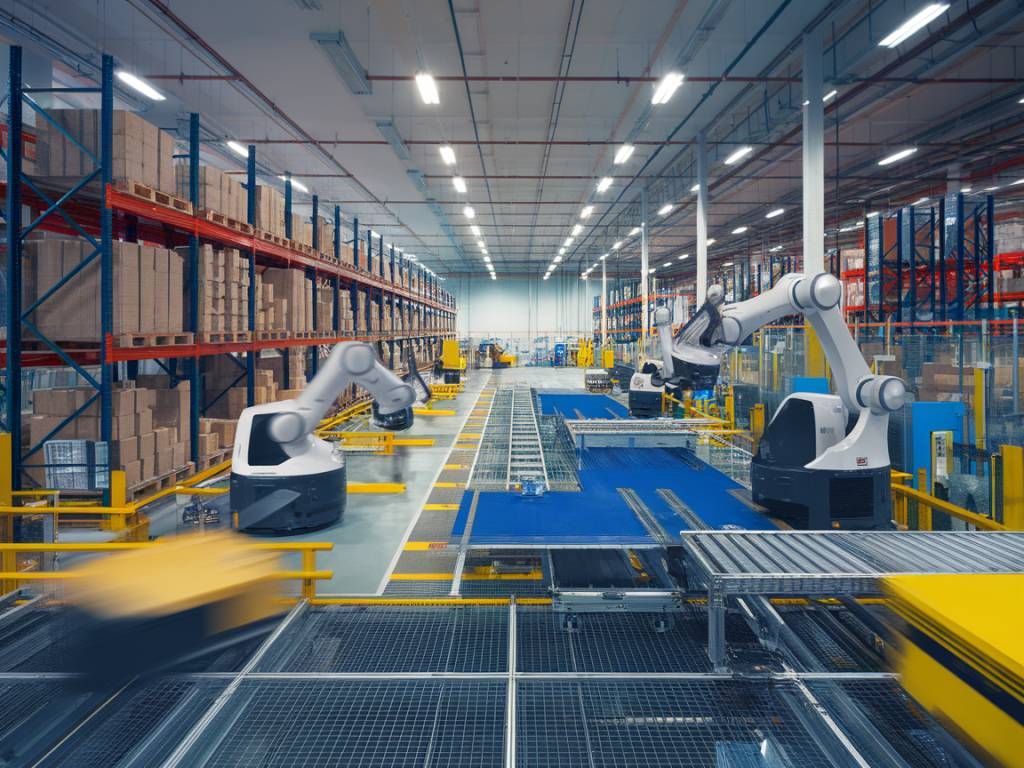As the logistics industry evolves, warehouse automation and robotics are increasingly becoming integral to optimizing operations. This transformation is driven by the need for efficiency, accuracy, and cost-effectiveness in the supply chain. In this article, we will explore the future of warehouse automation and robotics in logistics, touching upon key technologies, trends, and their impact on the industry.
Key Technologies in Warehouse Automation
Several key technologies are paving the way for advanced automation in warehouses. These innovations are gradually transforming how warehouses operate, offering enhanced productivity and flexibility.
Robotic Process Automation (RPA): RPA uses software robots to perform repetitive tasks. In warehouses, RPA can automate activities such as inventory management, data entry, and order processing, reducing human error and increasing efficiency.
Automated Guided Vehicles (AGVs): AGVs are mobile robots used to transport goods within a warehouse without human intervention. They follow predefined paths and are equipped with sensors to navigate and avoid obstacles, streamlining material handling processes.
Autonomous Mobile Robots (AMRs): Unlike AGVs, AMRs do not require predefined paths and can move freely within a warehouse. Using advanced sensors and machine learning algorithms, AMRs can intelligently navigate dynamic environments, making them ideal for complex warehouse layouts.
Pick-and-Place Robots: These robots are designed to pick items from storage and place them in the desired locations, such as conveyor belts or packaging stations. Equipped with advanced vision systems, pick-and-place robots can handle a wide range of products with varying shapes and sizes.
Warehouse Management Systems (WMS): WMS software integrates with automated systems to manage inventory, track shipments, and optimize warehouse layouts. By providing real-time data and analytics, WMS enhances decision-making and operational efficiency.
Trends Shaping the Future of Warehouse Automation
Several emerging trends are expected to shape the future of warehouse automation and robotics. Understanding these trends can help logistics companies stay ahead of the curve and leverage automation technologies effectively.
Increased Adoption of IoT: The Internet of Things (IoT) connects devices and sensors within a warehouse, enabling real-time monitoring and data collection. This connectivity allows for predictive maintenance, optimized resource allocation, and enhanced inventory management.
Artificial Intelligence and Machine Learning: AI and ML technologies are playing a crucial role in warehouse automation. By analyzing vast amounts of data, AI can optimize routing, predict demand, and enhance order accuracy. Machine learning algorithms enable robots to learn from their environment, improving their efficiency and adaptability over time.
Collaborative Robots (Cobots): Cobots are designed to work alongside human workers, enhancing productivity and safety. They can handle repetitive tasks, reducing the physical strain on human workers and allowing them to focus on more complex activities. The collaborative nature of these robots ensures a seamless blend of human-robot interactions.
Edge Computing: Edge computing processes data locally at the source, reducing latency and improving response times. In warehouses, edge computing can enable real-time decision-making, enhance robotics performance, and support IoT applications.
Sustainable Practices: As sustainability becomes a priority, warehouse automation is increasingly incorporating eco-friendly practices. Energy-efficient robots, renewable energy sources, and optimized resource usage contribute to reducing the carbon footprint of warehouses.
Impact on the Logistics Industry
The integration of advanced automation and robotics in warehouses has far-reaching implications for the logistics industry. Here are some key ways automation is transforming logistics operations:
Increased Efficiency: Automation streamlines warehouse operations, reducing the time and effort required for various tasks. This increased efficiency translates to faster order processing, reduced lead times, and improved customer satisfaction.
Improved Accuracy: Human errors in tasks such as order picking, inventory management, and data entry can be costly for logistics companies. Automated systems minimize these errors, ensuring higher accuracy and reducing the need for rework.
Cost Savings: While the initial investment in automation technologies can be substantial, the long-term cost savings are significant. Automated systems reduce labor costs, improve resource utilization, and minimize wastage, resulting in a higher return on investment.
Enhanced Flexibility: Automated warehouses can quickly adapt to changing demands and workflows. For instance, AMRs can be reprogrammed to handle new tasks or navigate different paths without extensive reconfiguration. This flexibility is crucial in responding to market fluctuations and seasonal peaks.
Scalability: Automation technologies enable warehouses to scale their operations effortlessly. As demand grows, additional robots or automated systems can be integrated without major disruptions, ensuring seamless scalability.
Labor Dynamics: While automation reduces the need for manual labor in repetitive tasks, it also creates opportunities for higher-skilled jobs. Workers can transition to roles that require supervision, maintenance, and management of automated systems, fostering a more skilled workforce.
Challenges and Considerations
Despite its numerous benefits, the adoption of warehouse automation and robotics comes with its share of challenges. Addressing these challenges is essential to maximizing the potential of automation technologies.
Initial Investment: The cost of implementing automation technologies can be a significant barrier for many logistics companies. A thorough cost-benefit analysis and long-term planning are crucial to justify the initial investment and ensure a positive return on investment.
Integration with Existing Systems: Integrating new automation technologies with existing warehouse management systems and infrastructure can be complex. Ensuring seamless compatibility and interoperability between different systems is essential for smooth operations.
Workforce Training and Adaptation: As warehouses transition to automated systems, workforce training and adaptation become essential. Workers must be trained to operate and manage new technologies, and companies must foster a culture of continuous learning and adaptation.
Maintenance and Downtime: Automated systems require regular maintenance to ensure optimal performance. Unexpected downtime or technical issues can disrupt operations, making preventive maintenance and quick response mechanisms vital for minimizing disruptions.
Data Security: The increasing reliance on interconnected systems and IoT devices raises concerns about data security and privacy. Robust cybersecurity measures must be in place to protect sensitive data and ensure the integrity of automated systems.
The Road Ahead
The future of warehouse automation and robotics in logistics is dynamic and promising. As technology continues to advance, warehouses will become more intelligent, efficient, and adaptable. Here are some key developments to watch for in the coming years:
Advanced AI and Analytics: Artificial intelligence and advanced analytics will play an even more significant role in warehouse automation. Predictive analytics will optimize inventory levels, reduce stockouts, and enhance demand forecasting, resulting in more streamlined supply chains.
5G Connectivity: The rollout of 5G networks will enable faster and more reliable communication between automated systems and IoT devices. This enhanced connectivity will support real-time data transfer, enabling quicker response times and better coordination within warehouses.
Human-Robot Collaboration: The concept of human-robot collaboration will continue to evolve, with robots becoming more intuitive and capable of working seamlessly with human workers. This synergy will enhance productivity and create a more harmonious work environment.
Global Integration: Automation technologies will become more integrated across global supply chains. Seamless communication and coordination between warehouses, distribution centers, and transportation networks will result in a more interconnected and efficient logistics ecosystem.
Personalized Automation Solutions: As automation technology becomes more accessible, logistics companies will have the opportunity to implement personalized solutions tailored to their specific needs. Customizable robots and automation systems will address unique challenges and optimize operations.
In conclusion, the future of warehouse automation and robotics in logistics is undeniably bright. As companies embrace these technologies, they can look forward to increased efficiency, accuracy, and scalability in their operations. By staying informed about emerging trends and addressing the associated challenges, logistics professionals can harness the full potential of automation to create a more resilient and dynamic supply chain.



